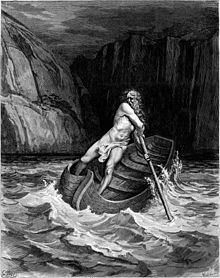Charon (mythology)


Charon ( ancient Greek Χάρων , short for χαροπός charopós "with sparkling eyes") is the gloomy, aged ferryman in Greek and Roman mythology who often takes the dead for an obolus (coin) in a boat across the Dead River - usually the Acheron also called the rivers Lethe and Styx - brings them to the realm of Hades , ruler of the underworld . The places of worship dedicated to the ferryman, mostly located in caves or rock openings, are called Charoneia .
myth
Charon, son of Erebos and Nyx , brings the dead across the River of the Dead to the entrance of Hades . Only those who have received the funeral rites and whose crossing has been paid for with a coin , the so-called “ Charonspfennig ” ( obolus ), are allowed on the ferry of this incorruptible ferryman . The dead put these coins under their tongues. According to myth, Charon denied access to the unburied dead, so that they would have to wander around the banks of the river as shadows for a hundred years before he would allow them to cross.
The first mention of Charon in Greek literature is an epic poem called Minyas, passed down as a fragment by Pausanias .
Representations
Greeks and Romans thought of Charon as a sinister and miserable old man, clad in a dark sailor's smock, as he did for example. B. was seen on the painting of Polygnot in the Lesche der Knidier in Delphi and is often depicted on Attic grave vases. On Etruscan tomb paintings, however, Charon is depicted as a hideous death demon.
Charon among the Etruscans
The Etruscans knew the god Charun , a kind of strangler with a half-animal appearance and armed with a large hammer. He was a warrior as well as a guard at the entrance to the grave gate and was the guide of the deceased into the underworld, like the Greek Hermes .
reception
- Charon is mentioned among others by Euripides , Aristophanes , Virgil , Ovid and Seneca .
- In Lukian's Charon or Contemplation of the World ( Χάρων ἢ ἐπισκοποῦντες ) he is the title character, and he also appears in his death dialogues .
- Dante Alighieri transfers it into Christian mythology in his Divine Comedy .
- In the novella Death in Venice by Thomas Mann Charon occurs in the form of the gondolier on which the protagonist Aschenbach over the lagoon to the Lido drives.
- In Friedrich Dürrenmatt's work The Judge and His Executioner , the car of the shot policeman Schmied is called the "blue Charon" in allusion to the mythological meaning.
- In the songs of the Modern Greeks , Charon lives on as Charos or Charontas , the stern, sullen old man who shoots his victim like a black bird as an "angel of death" or as a flying rider leads the multitudes of the dead through the air to the realm of the dead.
- The moon Charon of the dwarf planet Pluto is named after Charon .
literature
- Wilhelm Heinrich Roscher: Charon . In: Wilhelm Heinrich Roscher (Hrsg.): Detailed lexicon of Greek and Roman mythology . Volume 1.1, Leipzig 1886, Col. 884-886 ( digitized version ).
- Otto Waser : Charon 1. In: Paulys Realencyclopadie der classischen Antiquity Science (RE). Volume III, 2, Stuttgart 1899, Col. 2177 f. ( Digitized version ).
Web links
- Charon . In: Encyclopædia Britannica Online (English)
- Charon in the Theoi Project ( English )
- Warburg Institute Iconographic Database - Photos of Charon Representations in Art
Remarks
- ↑ Hans von Geisau : Charon 1. In: Der Kleine Pauly (KlP). Volume 1, Stuttgart 1964, column 1138 f.
- ↑ In a poem from the younger epic called Minyas, quoted in Pausanias , Description of Greece 10.28.2, the great age of Charon is emphasized; also Euripides , Alkestis 441, and Aristophanes , Die Fösche 139 f., aim at the old age of Charon.
- ↑ Michael Grant, John Hazel: Lexicon of ancient myths and shapes . 13th edition. dtv, Munich 1997, ISBN 3-423-32508-9 , p. 99 .
- ↑ Virgil , Aeneid 6,324-330.
- ↑ Pausanias, Description of Greece 10.28.2.
- ↑ Euripides, Alkestis 441.
- ↑ Aristophanes, The Frogs 139 f.
- ↑ Virgil, Aeneid 6,298-304 ( online ).
- ↑ Ovid, Metamorphoses 10.73 ("portitor")
- ↑ Seneca, Hercules furens 762-777.
- ↑ Lukian, Dialogues of the Dead 4 and 10.
- ^ Georg Friedrich Daumer : Hafis. A collection of Persian poems. Along with poetic additions from different peoples and countries. Hoffmann and Campe, Hamburg 1846, p. 317.

